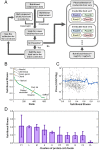Uncovering the nutritional landscape of food
- PMID: 25768022
- PMCID: PMC4359127
- DOI: 10.1371/journal.pone.0118697
Uncovering the nutritional landscape of food
Erratum in
-
Correction: Uncovering the nutritional landscape of food.PLoS One. 2015 Apr 29;10(4):e0127128. doi: 10.1371/journal.pone.0127128. eCollection 2015. PLoS One. 2015. PMID: 25923924 Free PMC article. No abstract available.
Abstract
Recent progresses in data-driven analysis methods, including network-based approaches, are revolutionizing many classical disciplines. These techniques can also be applied to food and nutrition, which must be studied to design healthy diets. Using nutritional information from over 1,000 raw foods, we systematically evaluated the nutrient composition of each food in regards to satisfying daily nutritional requirements. The nutrient balance of a food was quantified and termed nutritional fitness; this measure was based on the food's frequency of occurrence in nutritionally adequate food combinations. Nutritional fitness offers a way to prioritize recommendable foods within a global network of foods, in which foods are connected based on the similarities of their nutrient compositions. We identified a number of key nutrients, such as choline and α-linolenic acid, whose levels in foods can critically affect the nutritional fitness of the foods. Analogously, pairs of nutrients can have the same effect. In fact, two nutrients can synergistically affect the nutritional fitness, although the individual nutrients alone may not have an impact. This result, involving the tendency among nutrients to exhibit correlations in their abundances across foods, implies a hidden layer of complexity when exploring for foods whose balance of nutrients within pairs holistically helps meet nutritional requirements. Interestingly, foods with high nutritional fitness successfully maintain this nutrient balance. This effect expands our scope to a diverse repertoire of nutrient-nutrient correlations, which are integrated under a common network framework that yields unexpected yet coherent associations between nutrients. Our nutrient-profiling approach combined with a network-based analysis provides a more unbiased, global view of the relationships between foods and nutrients, and can be extended towards nutritional policies, food marketing, and personalized nutrition.
Conflict of interest statement
Figures




References
-
- Drewnowski A (1997) Taste preferences and food intake. Annu Rev Nutr 17: 237–253. - PubMed
-
- De Irala-Estevez J, Groth M, Johansson L, Oltersdorf U, Prattala R, Martinez-Gonzalez MA. (2000) A systematic review of socio-economic differences in food habits in Europe: consumption of fruit and vegetables. Eur J Clin Nutr 54: 706–714. - PubMed
-
- Drewnowski A, Popkin BM (1997) The nutrition transition: new trends in the global diet. Nutr Rev 55: 31–43. - PubMed
-
- Kittler PG, Sucher KP (2008) Food and Culture, 5th Ed. California: Thomson Wadsworth.
-
- Wardle J, Parmenter K, Waller J (2000) Nutrition knowledge and food intake. Appetite 34: 269–275. - PubMed
Publication types
MeSH terms
LinkOut - more resources
Full Text Sources
Other Literature Sources

